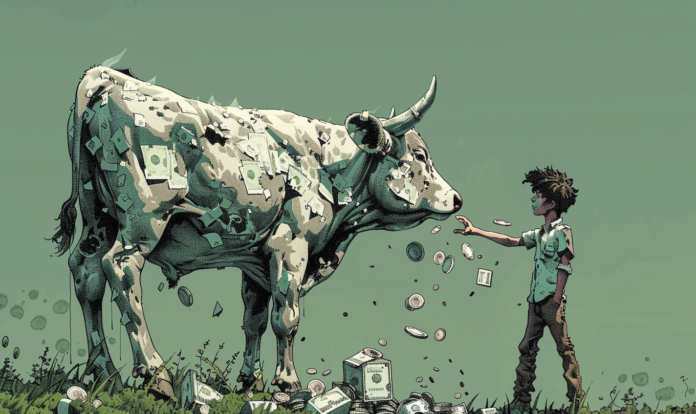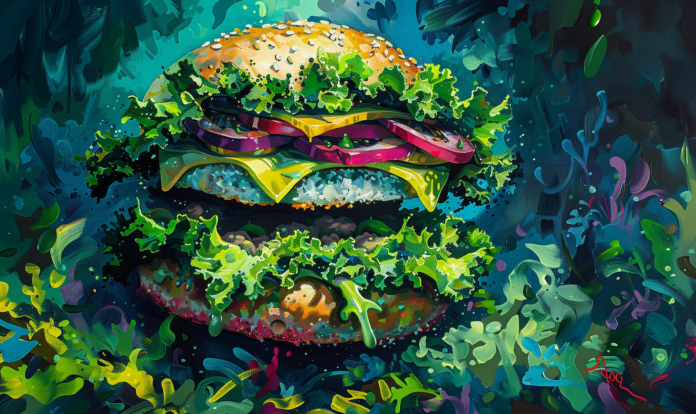First off, let’s talk about the elephant in the boardroom. Since 2019, agency holding companies have seen their share of the U.S. media market take a nosedive, losing a significant chunk of their former dominance.
That’s like Starbucks suddenly losing a third of its coffee sales to a hipster lemonade stand—unthinkable, yet here we are.
These corporate behemoths, once the gatekeepers of the advertising world with their bulk buying power and secret handshake deals, are now scrambling to stay relevant. They’re like flip phones in the age of smartphones—nostalgic but not particularly useful. As Sir Martin Sorrell, founder of S4 Capital and former CEO of WPP, quipped last year, “The traditional agency model is under significant pressure. Clients are demanding faster, better, cheaper solutions driven by technology and data.” It’s as if the giants are realizing they’ve been sleepwalking while the world moved on without them.
Brand Direct Spending: The Rebellion Gains Momentum
Meanwhile, brand direct ad spending has skyrocketed, surging ahead like a rocket fueled by cold brew and ambition. Brands are taking matters into their own hands, cutting out the middlemen faster than you can skip a YouTube ad.
This isn’t just a blip on the radar; it’s a full-blown movement. In recent years, in-house agencies have become the new black. Surveys indicate that over 80% of advertisers now have some form of in-house agency, a significant increase from just a few years ago. It’s as if brands collectively woke up one morning, chugged a double espresso, and thought, “Why rent the boat when we can build our own yacht?”
And they’re not just building yachts—they’re crafting luxury liners decked out with all the latest tech. Many brands have reported significant cost savings and improved agility since moving operations in-house. They’re able to pivot faster than a caffeinated figure skater, responding to market trends in real-time without waiting for agency turnaround times that feel slower than dial-up internet.
Marc Pritchard, Chief Brand Officer at Procter & Gamble, didn’t mince words when he declared, “We’re taking greater control of our media planning and buying to drive better effectiveness and efficiency.” P&G streamlined its agency roster and reinvested those resources into building internal capabilities. The result? More control, greater transparency, and a direct line to their consumers.
But it’s not just the big players getting in on the action. Brands of all sizes are jumping on the bandwagon, leveraging accessible technology and data analytics tools to punch above their weight. With programmatic advertising platforms becoming more user-friendly, companies no longer need a PhD in rocket science to launch effective campaigns. It’s DIY advertising, but with fewer glue sticks and more algorithms.
The shift towards direct media buying is reshaping the advertising landscape. Digital ad spend by brands directly is continuing to grow, signaling a significant change in how advertising budgets are allocated. It’s as if everyone got the memo that the best way to get things done is to do it yourself—or at least keep a much closer eye on who’s doing it for you.
The motivations are clear. Brands are hungry for transparency, craving agility, and eyeing cost savings like a hawk spotting its next meal. They’re tired of the opaque practices and sluggish pace often associated with big holding companies. In an era where a social media trend can rise and fall in a matter of hours, speed isn’t just nice to have—it’s essential.
In essence, brands are taking back control, and the advertising world is never going to be the same. The middlemen are feeling the squeeze, and direct engagement is becoming the norm rather than the exception. The message is loud and clear: if you want something done right, you might as well do it yourself. After all, who knows your brand better than you do?
So, What’s Fueling This Advertising Exodus?
In a word: Technology.
The digital revolution has shattered the media landscape into a kaleidoscope of platforms—social media, streaming services, podcasts, influencers, virtual reality experiences—you name it. It’s like the media gods tossed the old playbook out the window and said, “Let’s see what happens when we shake things up.” And boy, did they shake things up.
This explosion hasn’t just fragmented audiences; it’s democratized the tools needed to reach them. Remember when advertising on TV required a small fortune and a network connection? Now, a teenager with a smartphone can reach millions on TikTok before you’ve even had your morning coffee. It’s as if the gatekeepers have left the gates wide open, and everyone’s invited to the party.
Platforms like Google Ads, Facebook Ads, and TikTok’s advertising platform offer user-friendly interfaces that let brands target their audiences with sniper-like precision. Digital ad spending in the U.S. continues to surge, projected to exceed previous records in 2024 and beyond, accounting for an ever-growing share of total media ad spending. That’s not just dominating the market; that’s rewriting the entire script.
But wait, there’s more. Social media ad spending alone is expected to keep climbing, outpacing traditional channels and capturing an even larger slice of the advertising pie. Streaming services and connected TV platforms are seeing ad revenues soar, with platforms like YouTube consistently raking in billions in ad revenue each year. It’s like everyone suddenly realized that eyeballs are glued to screens of all sizes, and they’re racing to stake their claim.
Projections suggest this growth isn’t slowing down anytime soon. By the mid-2020s, digital ad spending in the U.S. is expected to reach new heights, making traditional media look like that old VCR collecting dust in your basement. The writing’s on the wall, and it’s written in ones and zeros.
Linda Yaccarino, former Chairman of Advertising at NBCUniversal and now leading the charge at X (formerly Twitter), summed it up nicely when she said that the future of advertising lies in personalization and direct engagement with consumers through digital platforms. Brands are embracing this future with open arms—and open wallets. They’re pouring resources into digital strategies, influencer partnerships, and personalized content that speaks directly to consumers.
The rise of programmatic advertising has also played a significant role. Programmatic ad spend is expected to account for the vast majority of all digital display ad spending by 2024 and beyond, automating the ad buying process and allowing for real-time adjustments. It’s like having a personal assistant who’s always on, ensuring your message hits the right person at the right time.
In this new landscape, data is king. Brands are leveraging consumer insights to tailor their messages, creating a more intimate connection with their audiences. Studies have shown that a significant majority of consumers are more likely to make a purchase when brands offer personalized experiences, and brands are stepping up to the plate.
The bottom line? Technology hasn’t just changed the game; it’s flipped the board, scattered the pieces, and invited everyone to play. The democratization of advertising tools means that brands no longer need to rely on big agencies to reach their audiences. They have the power, and they’re using it to forge direct, meaningful connections with consumers.
The Paradox of Choice: Liberating Yet Overwhelming
But let’s not kid ourselves; the smorgasbord of advertising options today can be as overwhelming as trying to pick a movie on Netflix when you’re three episodes deep into indecision and starting to question your life choices. Brands—especially the smaller ones—might feel like they’re navigating a labyrinth designed by a mischievous minotaur armed with pop-up ads and autoplay videos.
It’s like walking into an all-you-can-eat buffet with a plate the size of a coaster. Sure, the options are endless, but where do you even start? Do you pile on the social media salad, grab a slice of influencer marketing pizza, or dive into the steaming hot dish of programmatic ads? By the time you’ve made a decision, the buffet is closed, and you’re left hungry and slightly confused.
Bob Liodice, the big cheese over at the ANA, summed it up when he said, “While bringing capabilities in-house offers control, it also requires significant investment in talent and technology.” Translation: just because you bought a fancy set of knives doesn’t mean you’re ready to be the next Iron Chef. Some brands think they’re too small to catch an agency’s eye and decide to go it alone, sometimes biting off more than they can chew—like ordering the spiciest item on the menu without checking the Scoville scale.
On the flip side, larger brands may feel shackled to the big holding companies, convinced that only a Titanic-sized agency can handle their colossal needs. It’s as if they’re afraid that jumping ship will leave them stranded on a deserted island with nothing but a volleyball for company. Meanwhile, doubts about transparency and effectiveness loom larger than a bad sequel to a horror franchise.
The irony? In a world bursting with choices, brands are feeling more paralyzed than ever. It’s the paradox of choice on steroids. Small brands worry about having the resources to manage complex campaigns, while big brands fret over whether their gargantuan agencies are nimble enough to keep up with the pace of change—or if they’re just lumbering giants dancing to last year’s tunes.
It’s a classic case of FOMO meets analysis paralysis. Brands don’t want to miss out on the latest marketing craze, but they’re also terrified of making the wrong move. It’s like being at a party where everyone else seems to know the secret handshake, and you’re awkwardly hovering by the punch bowl.
But here’s the kicker: the fear of making a misstep often leads to stagnation, which in this fast-paced digital age, is the biggest misstep of all. As the options multiply like rabbits on caffeine, the need for clear strategy and guidance becomes paramount. Otherwise, brands risk wandering the advertising wilderness like lost souls searching for Wi-Fi in a dead zone.
Trust Issues: The Not-So-Secret Ingredient
But let’s dive deeper into the trust issues that have been plaguing the industry like a bad Wi-Fi connection during a Zoom call. The relationship between brands and agencies has become as strained as trying to explain NFTs to your grandparents. Concerns over transparency, hidden fees, and data ownership have made brands as wary as a cat near a bathtub.
It’s like discovering that your fitness tracker isn’t just counting your steps but also selling your jogging routes to the highest bidder. Suddenly, that morning run feels less like a healthy habit and more like a data leak waiting to happen—not exactly the kind of motivation you signed up for.
Keith Weed, former Chief Marketing and Communications Officer at Unilever, nailed it when he said, “Transparency isn’t just a nice-to-have; it’s essential for building trust between brands and their partners.” And when someone who’s steered a corporate giant like Unilever speaks up, you might want to put down your latte and pay attention.
When trust erodes, so does the willingness to stick with the status quo. Brands start questioning whether their agencies are strategizing in their best interest or just taking them for a ride down Expense Lane. It’s like paying for premium gas and realizing you’ve been siphoned regular all along.
This breakdown in trust has pushed brands to rethink their relationships with agencies. They’re no longer content with vague reports and glossy presentations that say a lot but mean very little. They want transparency served up hotter than a fresh cup of coffee on a Monday morning.
Brands are asking pointed questions: Where exactly is our money going? How are you using our data? Why does this invoice look like it was written in hieroglyphics? It’s a corporate version of “It’s not me, it’s you,” and agencies are feeling the heat.
The fallout? Brands are more inclined to bring operations in-house or seek out partners who won’t make them feel like they’re playing a game of financial hide-and-seek. After all, in an age where data breaches are as common as celebrity apologies, who can afford to take chances?
In the end, it’s simple: Trust is the new currency, and brands are not willing to bankrupt themselves emotionally or financially. The agencies that get this will adapt and survive; those that don’t might find themselves as outdated as a fax machine in a 5G world.
Navigating the Media Maze: You’re in Control
But seriously, what’s a brand to do in this brave new world where the advertising landscape shifts faster than you can say “algorithm update”? First off, recognize that you have options. It’s like walking into an ice cream parlor with 100 flavors after years of being stuck with plain vanilla—you don’t have to settle anymore. And let’s be honest, who wants vanilla when you can have triple-chocolate-fudge-swirl with a dash of influencer sprinkles?
Define what matters most to you. Is it transparency? Because, let’s face it, nobody likes hidden fees or finding out their ad budget is being spent on bot farms in Siberia. Or maybe agility is your jam—the ability to pivot on a dime when the next TikTok trend explodes overnight. Perhaps you’re craving specialized expertise in emerging platforms like Twitch or Discord, where the youths are hanging out these days, speaking in memes and crafting the next viral sensation. Maybe it’s a combo platter of all these things.
Don’t be afraid to mix and match your approach. This isn’t a monogamous relationship; it’s more like speed dating with purpose. Many brands are finding success with hybrid models, maintaining certain capabilities in-house—where you can keep an eye on things—while collaborating with specialized agencies or consultants for those wildcards that require a bit more flair. It’s like having your cake and eating it too, without worrying about the calories.
Debbie Morrison, the Managing Director at Ebiquity, puts it succinctly: “Brands should assess their internal capabilities and consider partnerships that complement their strengths while filling in gaps.” In other words, you don’t have to go it entirely alone—just be smart about who you bring along for the ride. Think of it as assembling your own Avengers team, minus the spandex suits (unless that’s your thing, no judgment here).
Here’s the kicker: Flexibility is your secret weapon. The digital landscape changes more often than a teenager’s selfie poses, and you need partners who can keep up. That might mean partnering with a boutique agency that’s dialed into the TikTok zeitgeist or hiring a consultant who can navigate the murky waters of programmatic advertising without getting seasick.
Customization is king. The one-size-fits-all model is as outdated as dial-up internet. You wouldn’t wear the same outfit to a board meeting and a beach party, so why would you use the same advertising strategy across all platforms? Tailor your approach to fit your brand’s unique voice and the specific channels where your audience actually spends their time doom-scrolling.
So, shake things up. Break the mold. Challenge the old narratives that say you have to choose between going it alone or handing over the keys to a big agency that’s more interested in billable hours than your brand’s soul. The power is in your hands—or at least, it’s within your grasp if you’re willing to reach for it.
Remember, in today’s digital ecosystem, standing still is the quickest route to obsolescence. Don’t just dip your toes in the water; cannonball into the deep end. Sure, it might be a little chilly at first, but you’ll quickly warm up to the endless possibilities that come with taking control of your advertising destiny.
In the immortal words of someone probably famous, fortune favors the bold. So go ahead—be bold. Your brand deserves nothing less..
Final Musings and Some Unsolicited Advice
The advertising world is undergoing a transformation more dramatic than a reality TV show reunion—minus the thrown wine glasses but with all the drama. The old guard is being challenged, and brands are embracing new ways to connect with their audiences faster than you can say “viral TikTok dance.”
As I quipped last year, “In this fast-paced digital era, standing still is the same as moving backward. If you’re not ready to pivot, prepare to be left behind.” And let’s face it, nobody wants to be that brand still trying to make fetch happen.
Brands aren’t waiting for the industry to catch up; they’re forging ahead, leveraging technology and data to create meaningful connections. They’re like digital pioneers, charting unknown territories while the old mapmakers are still arguing over compass directions.
So, here’s some unsolicited advice, sprinkled with a dash of irreverence:
- Be audacious. The safe path is overcrowded and, frankly, a bit dull. Take risks. If you fail, at least you’ll have a good story to tell at conferences.
- Stay curious. The moment you think you’ve got it all figured out is the moment someone else disrupts the market with a dancing hologram.
- Take control. It’s your brand, your message, your audience. Don’t hand over the keys to someone who still thinks MySpace is a hot marketing channel.
- Seek guidance, but choose wisely. Not all who wander are lost, but a good GPS never hurt anyone. Collaborate with those who get your vision and can help you navigate the ever-changing landscape.
In the immortal words of… well, me: “If you’re not disrupting, you’re being disrupted.” So go ahead—shake things up, break the mold, and make some noise. The advertising world is your oyster, and it’s high time you shucked it open.
After all, why blend in when you were born to stand out?





















